|
The
Reacher Feature
(Told
you so)
As predicted, November ended with Lee Child’s latest
Jack Reacher novel, Night School (Bantam) as the Number 1 bestseller, despite stiff
competition from Ian Rankin, Michael Connelly, Robert Harris, Ben Aaronovitch,
John Grisham and Martina Cole.
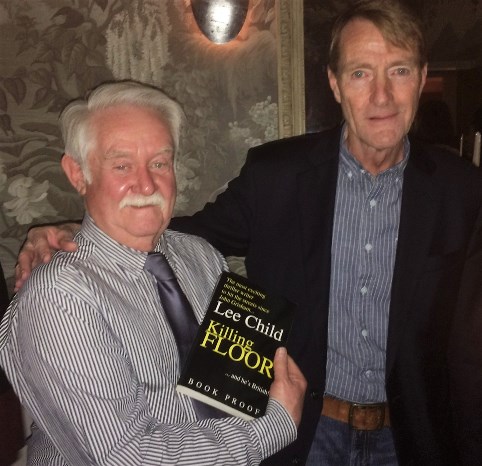 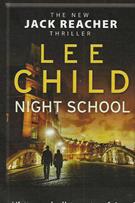
The excellent Night School (which goes back into
Reacher’s army career in the mid-1990s) was the 21st Reacher novel
in twenty years and therefore a spectacular party to celebrate the event was
called for and duly happened at a luxurious London venue positively awash with
champagne.
Naturally the ‘birthday boy’ was inundated with
hundreds of requests to sign copies of his new thriller, but to break the
monotony (signing sessions can be quite tiring, or so I’m told) I asked Lee to
sign the bound proof of Killing Floor, the first Reacher
novel, which I was sent to review in 1997 and have treasured ever since. (And
despite the cynical mutterings of some of the hacks present who observed this
event, that proof did not appear on E-Bay the next day, but remains in pride of
place in one of the libraries here at Ripster Hall.)
Winter
Warmer
The Winter Lunch of the Margery Allingham Society
was, as usual, a convivial affair with members wining and dining in a hostelry
not far from Margery Allingham’s old stomping ground in her student days in
London. (Pictures: Lesley Simpson).
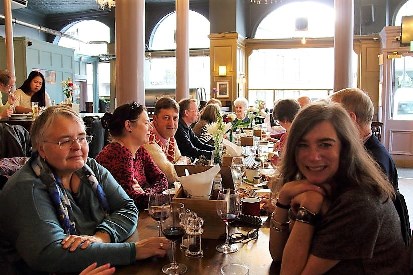
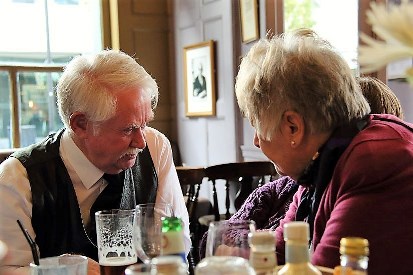
Whilst most members behaved impeccably, it is an
unwritten law that when two crime writers get isolated on the end of a table
(in this case the wonderful Ann Granger and myself), polite conversation
quickly descends into gossip and plotting.
Words
of War
At this year’s convention on crime fiction at St
Hilda’s College, Oxford, I understand that the distinguished, multi-award
winning author Andrew Taylor spoke on the appeal of historical mysteries. In
particular, he made the point that one identifiable trend in the
history-mystery was the undoubted popularity of novels set around World War II
– before, during and after – which were thought to attract more male readers to
the sub-genre. It was a very intelligent observation, no doubt fluently argued
by Andrew, although I am of course going on rumour and hearsay as I am not
allowed on the hallowed ground of St Hilda’s – the cost and disruption of
re-consecration being prohibitive these days.
I have long held the view that the Second World War
would make a comeback as a popular setting for thriller writers, especially
(but not exclusively) British authors, as it did in the 1960s and early 1970s
when the likes of Alistair MacLean, Jack Higgins, Clive Egleton, Duncan Kyle,
Brian Callison and Frederick Forsyth all dominated international bestseller
lists with stories set during or based on the war.
In 2016 alone, we have seen excellent thrillers set
around the wartime period from Philip Kerr, Elizabeth Wilson, Sam Eastland,
John Lawton, Chris Petit, Alan Furst, Mark Mills and Martin Cruz Smith. And
there are more on the way.
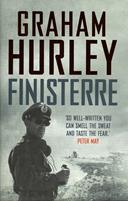
Out this month from Head of Zeus is Finisterre
by Graham Hurley, a crime writer noted for mysteries set in the West Country
which has been successfully transposed in to a French television series. Set at
the end of 1944, Finisterre follows two narrative lines; the wrecking of a
German U-Boat on a secret mission off the coast of Spain and its sole-survivor,
the badly injured Captain, and the highly suspicious suicide of a German
scientist working in the top secret American atom bomb project at Los Alamos in
New Mexico.
Eventually the two narratives coalesce into a plot
which revolves around the Nazis own plans for an atomic bomb and Hurley
cleverly provides cameo roles for real historical figures including Robert
Oppenheimer, J. Edgar Hoover and Walter Schellenberg.
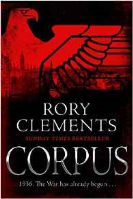
And in January, Rory Clements, best known for his
Tudor settings, moves into the twentieth century with Corpus, published by
Zaffre, and a murder mystery which turns into a spy novel set in 1936. Ranging
from Berlin to Cambridge and the plight of Jewish scientists avoiding the
Gestapo, Corpus ranges across the turmoil of the international scene and
the looming war and even the scandal surrounding King Edward VIII and Wallis Simpson.
Tipping
the Scales
At different ends of the scale – physically – two
titles out now provide perfect Christmas gifts for mystery buffs.

I suspect the hand of Richard Reynolds, of Heffers
Bookshop in Cambridge is behind the facsimile reproduction of the 54-page story A
College Mystery by A.P. Baker, partly because it is set in Christ’s
College, Cambridge, but mainly because it was originally published in 1918 by
‘W. Heffer Publishers’. The reissue comes from Ostara Publishing as part of its
Cambridge Crime series.
Arthur Ponsford Baker (1873-1918) was a lecturer in
history at Christ’s College and his ghostly mystery follows what young media
studies’ students would call the ‘found footage’ technique, but in fact owes
more to Wilkie Collins than to the Blair Witch.
At the other end of the scale, weighing in at 994
pages is the magisterial Jack the Ripper edited by Otto
Penzler and published by Head of Zeus.

This is far more than a re-tread of the known facts
about Whitechapel’s most notorious tourist in 1888 – for that Otto Penzler
recommends Donald Rumbelow’s excellent 1975 study The Complete Jack the Ripper –
although the basic details are set out in the early section, along with
commentaries from amateur and professional ‘Ripperologists’ as diverse as Maxim
Jakubowski, Robin Odell, George Bernard Shaw and American thriller writer
Stephen Hunter, who also contributes to the collection of Ripper-inspired fiction
later in the book.
It is the fiction inspired by the legend which
provides the real meat in Penzler’s Jack the Ripper, and Otto has
assembled a truly stellar cast of contributors, including: Anthony Boucher,
Boris Akunin, Jeffery Deaver, Ellery Queen, Ramsey Campbell, Robert Bloch,
Harry Turtledove and Anne Perry. The perfect nugget nestling at the heart of
this mammoth compendium, however, is the chance to read Marie Belloc Lowndes’
influential The Lodger in both forms: the original short story from 1911
and then the full novel from 1913 (later filmed, silently, by Alfred
Hitchcock).
I suspect the timing of this book’s compilation – a
positively Herculean achievement by the editor – prevented the inclusion of something from one
of the most recent contributions to the study of all things Ripper, Wynne Weston-Davis’ investigation into the
identity of Mary (or Marie) Kelly, the killer’s fifth (or seventh?) victim, now
titled Jack the Ripper: A True Love Story. In the book, Weston-Davis puts up a convincing
case that Kelly was his great-aunt, and the aunt of his father, who was better
known in Britain in the 1960s as thriller writer and Chairman of the Crime
Writers’ Association Berkely Mather.
Catching
Up
Now the nights have drawn in I make my annual
attempt to catch up on books I should have read a long time ago. Two in
particular have been especially rewarding and I can’t think why it has taken me
so long to get around to them.
I defer to no-one in my admiration for Geoffrey
Household (1900-1988), author of that perfectly-formed classic Rogue
Male (and the highly recommendedWatcher in the Shadows and Rogue
Justice), but for some reason I had never read his politically
picaresque adventure story The High Place, first published in
1950.
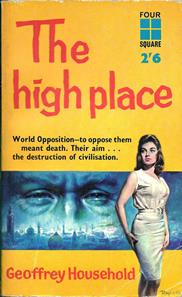
The plot revolves around an organisation called
‘World Opposition’ – although this is no SPECTRE-like gang of villains, but an
international body of libertarian, rather amiable, anarchists based in an old
fortress in Syria. The hero, a typical Household character, is a well-meaning
romantic Englishman who lives and works in Syria having had too many run-ins
with petty-fogging bureaucrats back home in post-war Britain. Naturally he
falls madly in love with the mittel-European woman who runs World Opposition
and helps, through his links as an import/export agent in smuggling supplies to
the isolated fortress base.

Geoffrey Household spent several years in Syria during
WWII serving in Field Security units of the British army, knew the country well
and clearly had a fondness for it and its people. What gave The
High Place a particular poignancy for me was the fact that as I was
reading it, the radio and television news programmes were reporting the horrors
of life in present day Aleppo, one of the key locations in Household’s story
and a place he describes with great affection. In many ways I am rather glad
Geoffrey Household isn’t around to listen to the news bulletins from his
beloved Syria.
The majority of my readers will, I am sure, be aware
of the classic 1944 film noir Laura based on the book by American
Vera Casprey (1899-1987) - a book which my factotum Waldo Lydecker attempted to
have banned. Yet how many are familiar with her 1945 novel (also filmed though
less famously) Bedelia? I know I was not, until now.
 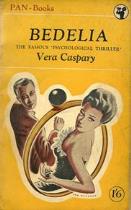
Set in a wealthy social enclave of snowbound New
England at Christmas 1913, Bedelia is, as my 1950 Pan edition
proclaims, ‘a psychological thriller’ about a (seemingly) gentle and rather
fragile recently-married woman playing hostess to her new neighbours. But the
frail Bedelia is not the victim here: her new, older and rich husband, though,
just might be. As the snow falls and isolates the house, the story of Bedelia’s
previous husbands –and their fate – emerges and the ending fulfils the basic
criteria of noir fiction: from the
start, the reader knows this isn’t going to end well…
|
|
Old Friends
The late, great Gore Vidal famously quipped that ‘every time a friend succeeds, something inside me dies’ and while I admired the wit, I could never really bring myself to agree with the sentiment, being, as everybody knows, something of an old softy.
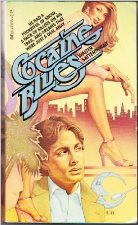
So I am genuinely happy to see a new novel (even if only published in the USA) from my fellow boulevardier Walter Satterthwait, whose surname may sound like that of a nineteenth-century Lancashire brewer but who was, when he frequented the London scene in the 1990s, rightly perceived as something of a Cool Dude. This may have been due to the fact that he wrote his first novel, Cocaine Blues, whilst working as a professional bartender in New York City. It is a book I have never actually read and copies are now so valuable that they are beyond the means of the average pensioner. (The last time I looked, one was on offer, second-hand, for £150 – or almost 10 Euros, post-Brexit.)
After a writing career which saw a highly-regarded series of private eye novels and light-hearted historical thrillers featuring real-life characters (including, among others, Oscar Wilde, Doc Holliday, Arthur Conan Doyle, Harry Houdini and Ernest Hemingway), for his new novel, New York Nocturne, Walter revives one of his early successes in blending historical figures into a slick mystery, by having as a protagonist the notorious (but judged innocent) Lizzie Borden who inspired the nursery rhyme (some nursery!) Lizzie Borden took an axe and gave her mother forty whacks…
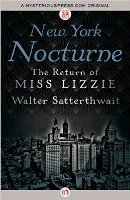
Having famously utilised the character in his 1989 novel Miss Lizzie, Satterthwait moves his scene to New York in 1924 and once again his narrator is the young teenager Amanda Burton who is, initially, the prime suspect in the murder of her uncle (murder by axe, naturally) in the fashionable Dakota Building. The ageing Lizzie Borden rides to Amanda’s rescue, accompanied by none other than a certain Dorothy Parker, a guarantee if one was ever needed that the repartee is going to sparkle.
New York Nocturne – The Return of Miss Lizzie is, quite simply, a delight, full of great characters, sly jokes and lots of lovely references to Jazz Age New York, including name-checks for the young Louis Armstrong, the Cotton Club and a spectacular tap-dancing sensation on the night club scene: George Raft. (I despair, but younger readers may well have to resort to Google on that one.)
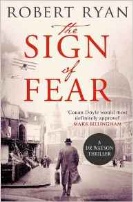
I am also pleased (honest I am) to see Robert Ryan’s fourth thriller to star the most famous sidekick in crime fiction, Dr John Watson, being published in paperback by Simon & Schuster. Now simply getting into paperback would not normally be a cause for overt joy and excitement, but the hardback edition of The Sign of Fear was allowed to slip out ‘under the radar’ with no fanfare whatsoever, way back in January, much to the puzzlement of a growing army of fans, including myself, who regard this ‘continuation’ franchise as an outstanding achievement.
The setting is London in 1917 and Watson, back from a torrid time on the Western Front faces equally hazardous alarums and excursions on the home front. There is no Sherlock Holmes to turn to, but Watson finds an unlikely ally from a previous novel in this most excellent series which makes most Holmes & Watson continuations – and they are legion – taste like wet cardboard.
And my joy knows no bounds (I am contractually obliged to say this) to see two of Peter Guttridge’s hysterical ‘Nick Madrid’ comic mysteries back in print from Ostara: Foiled Again and Cast Adrift.
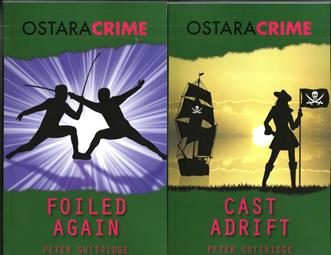
Although in recent years Peter has moved successfully into more serious crime fiction, he made his name with five comedy thrillers starring the self-depreciating, yoga-practising, accident-prone journalist Nick Madrid. (And why ‘Madrid’ is an unusual surname for somebody who comes from Burnley is a question answered in Foiled Again). Peter’s other obsession (and Nick Madrid’s) is Hollywood and in Cast Adrift he satirically skewers the fiasco of film-making big-time as his hapless hero gets involved in the making of a pirate musical (!) with an ill-starred cast of misfits somewhere not a million miles from the Caribbean…
Comedy crime is a difficult sub-genre to master and when first published, his books were blurbed with a quote saying that Peter was ‘the funniest crime writer in England’. That got me laughing right there, as dear old Gore would have said.
Happy New Reading Year
By mid-November I already had more than 75 proof copies or advance copies of crime novels scheduled for 2017 and have had a chance to give a cursory glance to only a few.
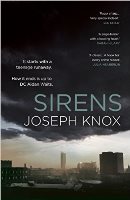  One in particular did, however, catch my eye because I had recently been introduced to the personable (and appallingly young) debut author, and thus required serious consideration. Sirens by Joseph Knox (from Doubleday in January) is a down-and-dirty slice of Manchester noir with a disgraced, and often disgraceful, police detective working his way into a drug-dealing underworld in search of a missing girl and the solution to an unsolved murder. Impressively bleak, this is the most gripping description of the unwholesome underbelly of the city that I have read since Nicholas Blincoe’s gender-bending Manchester Slingback almost twenty years ago. One in particular did, however, catch my eye because I had recently been introduced to the personable (and appallingly young) debut author, and thus required serious consideration. Sirens by Joseph Knox (from Doubleday in January) is a down-and-dirty slice of Manchester noir with a disgraced, and often disgraceful, police detective working his way into a drug-dealing underworld in search of a missing girl and the solution to an unsolved murder. Impressively bleak, this is the most gripping description of the unwholesome underbelly of the city that I have read since Nicholas Blincoe’s gender-bending Manchester Slingback almost twenty years ago.
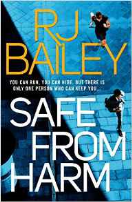 Straight to the top of my groaning to-be-read pile will go Safe From Harm by debut author(I think, as the name is a new one on me) R.J. Bailey, coming from Simon & Schuster, which features Sam Wylde, a female Close Protection Officer in what seems destined to be the first in a series. Straight to the top of my groaning to-be-read pile will go Safe From Harm by debut author(I think, as the name is a new one on me) R.J. Bailey, coming from Simon & Schuster, which features Sam Wylde, a female Close Protection Officer in what seems destined to be the first in a series.
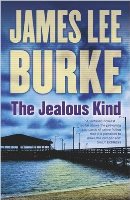 Someone who needs no introduction is James Lee Burke and he has a new novel – something of a departure – out in January from Orion, The Jealous Kind. It is tantamount to heresy to criticise Lee Burke, who has made such a major contribution to American crime fiction, but am I alone in having lost patience with the sermonizing and often blinkered view of social evils of his main protagonist Dave Robicheaux in recent years? (Not to mention the free reign he gives Robicheaux’s psychotic sidekick to perpetrate gold standard bullying and unspeakable acts of violence.) What was never in doubt was the fact that Lee Burke is a fine writer and a unique stylist when on home turf and The Jealous Kind takes him back (I suspect) to his roots with its Texas setting in 1952 and a character called Aaron Holland Broussard – a name straight out of the Lee Burke canon. Someone who needs no introduction is James Lee Burke and he has a new novel – something of a departure – out in January from Orion, The Jealous Kind. It is tantamount to heresy to criticise Lee Burke, who has made such a major contribution to American crime fiction, but am I alone in having lost patience with the sermonizing and often blinkered view of social evils of his main protagonist Dave Robicheaux in recent years? (Not to mention the free reign he gives Robicheaux’s psychotic sidekick to perpetrate gold standard bullying and unspeakable acts of violence.) What was never in doubt was the fact that Lee Burke is a fine writer and a unique stylist when on home turf and The Jealous Kind takes him back (I suspect) to his roots with its Texas setting in 1952 and a character called Aaron Holland Broussard – a name straight out of the Lee Burke canon.
 Another Famous Name, and an author who has been a best-seller even longer than James Lee Burke, is Gerald Seymour and in Jericho’s War from Hodder in January, he puts all his previous expertise as a foreign reporter into a thriller set in the Yemeni desert and a plot to take out a leading figure in Al Qaeda. Seymour also, I should point out, brings the knack of knowing how to write a tense modern thriller, something he’s been doing since 1975. Another Famous Name, and an author who has been a best-seller even longer than James Lee Burke, is Gerald Seymour and in Jericho’s War from Hodder in January, he puts all his previous expertise as a foreign reporter into a thriller set in the Yemeni desert and a plot to take out a leading figure in Al Qaeda. Seymour also, I should point out, brings the knack of knowing how to write a tense modern thriller, something he’s been doing since 1975.
 Crime fiction set in modern Greece is not unknown, but it is rare (compared to, say, the killing fields of Scandinavia) and I know little, in fact nothing, of the leading Greek practitioners of the art. But I do trust that innovative publisher Bitter Lemon Press and if they are publishing Athenian Blues by Pol Koutsakis in January, then I will certainly give it a try. Originally published in Greece in 2010, this first in a series to feature hitman (though he prefers the term ‘problem-solver’) Stratos Gazis who finds plenty of work in the chaos of the Greek economic meltdown. I believe it has been translated by the author, an award-winning playwright, who recently emigrated from Greece to Perth in Australia. Crime fiction set in modern Greece is not unknown, but it is rare (compared to, say, the killing fields of Scandinavia) and I know little, in fact nothing, of the leading Greek practitioners of the art. But I do trust that innovative publisher Bitter Lemon Press and if they are publishing Athenian Blues by Pol Koutsakis in January, then I will certainly give it a try. Originally published in Greece in 2010, this first in a series to feature hitman (though he prefers the term ‘problem-solver’) Stratos Gazis who finds plenty of work in the chaos of the Greek economic meltdown. I believe it has been translated by the author, an award-winning playwright, who recently emigrated from Greece to Perth in Australia.
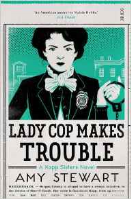 And whilst on the subject of Australia (Warning: Tenuous Link ahead), but also New York City in 1915, it has fallen to Australian Small Publisher of the Year(several years actually) Scribe to introduce to the UK Amy Stewart’s Lady Cop Makes Trouble. Based on the true story of Constance Kopp, America’s first female deputy sheriff (with a surname like that what else could she be?), and her sisters, I predict this series could become something of a cult. And whilst on the subject of Australia (Warning: Tenuous Link ahead), but also New York City in 1915, it has fallen to Australian Small Publisher of the Year(several years actually) Scribe to introduce to the UK Amy Stewart’s Lady Cop Makes Trouble. Based on the true story of Constance Kopp, America’s first female deputy sheriff (with a surname like that what else could she be?), and her sisters, I predict this series could become something of a cult.
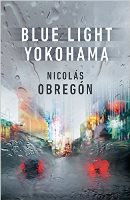 Moving into February, a complete change of scene is offered in Blue Light Yokohama by Nicolás Obregón, published by Penguin. British born of Spanish parents, Nicolás Obregón grew up between London and Madrid but was fascinated by Japan long before he first visited the country. Blue Light Yokohama, his debut crime novel, introduces the detective team of Inspector Kosuke Iwata and Assistant Inspector Nuriko Sakai investigating a bizarre ‘home invasion’ murder, which is actually based on a real case. Given the growing interest in Japanese crime fiction, this is definitely one to watch. Moving into February, a complete change of scene is offered in Blue Light Yokohama by Nicolás Obregón, published by Penguin. British born of Spanish parents, Nicolás Obregón grew up between London and Madrid but was fascinated by Japan long before he first visited the country. Blue Light Yokohama, his debut crime novel, introduces the detective team of Inspector Kosuke Iwata and Assistant Inspector Nuriko Sakai investigating a bizarre ‘home invasion’ murder, which is actually based on a real case. Given the growing interest in Japanese crime fiction, this is definitely one to watch.
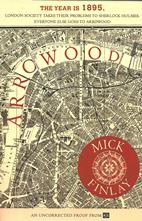
Even further ahead, in March, and a welcome relief I suspect for fans of Ripper Street suffering withdrawal symptoms, keep an eye out for Arrowood by Mick Finlay from HQ, a new imprint of HarperCollins. The setting is London in 1895 and as the advance publicity says, ‘London Society takes their problems to Sherlock Holmes, everyone else goes to Arrowood’ and Arrowood is a private detective who despises Sherlock Holmes. Sounds irresistible.
One of the most talked-about books of 2017 – so we might as well start now – will undoubtedly be Into the Water from Doubleday in May. This is the much anticipated new novel by Paula Hawkins following the runaway train (sorry, couldn’t resist) success of Girl on A Train.

And Then There Were Nuns
In this month’s unofficial ‘Vintage Corner’ I feature two books by an author I have to admit I know little, if anything, about, Eric Shepherd.
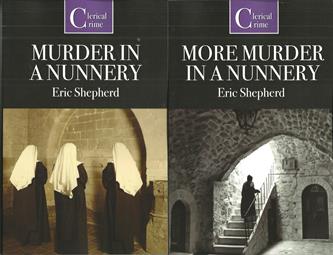
Murder in a Nunnery (first published in 1940) and the no-doubt long-awaited sequel More Murder in a Nunnery (1954) are attractively republished in the Clerical Crime imprint of Ostara Publishing and I am sure they will make the ideal Christmas present for readers of Golden Age detective stories and possibly even fans of Father Ted.
The Long Walk to Cover Art
Almost exactly a year ago I pointed out the trend in covers of crime novels which featured ‘the girl walking away’ and for a while, readers seem to be spared the confusion of such a ubiquitous image. I am afraid that in the latter months of 2016, the trend has re-surfaced.
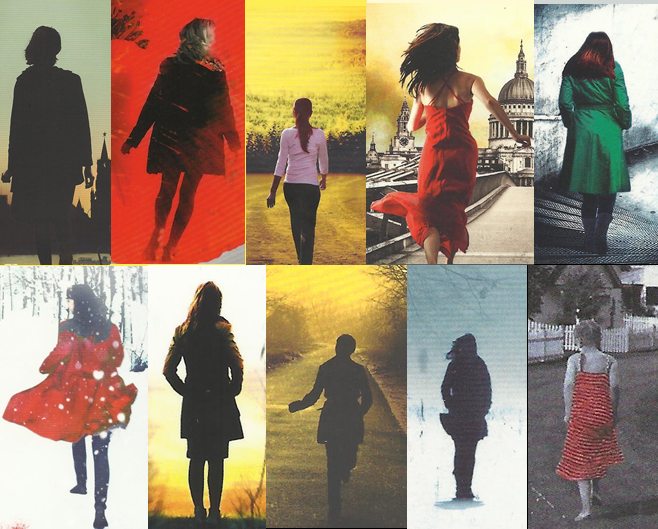 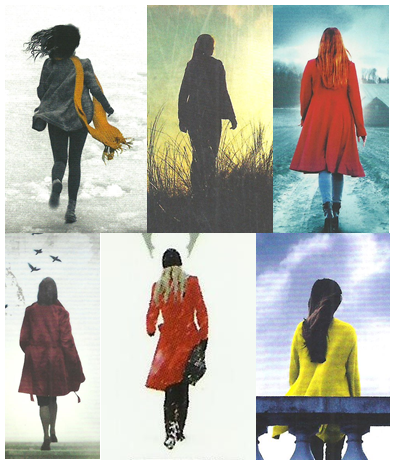
2015 2016
Picks of the Year
As there are far too many awards for crime fiction these days, we no longer give prizes at Shots - well, not since the prize fund was lost in rather cavalier bets on Brexit and Trump. I do have the perk, however, of picking my favourite books of the year but with it comes the restriction, in a very good year, of limiting my choices to only three.
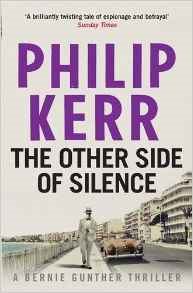 : : 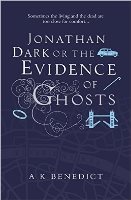 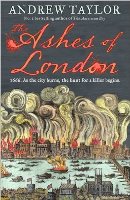
Philip Kerr’s The Other Side of Silence [Quercus] showed that you just can’t keep a character as good as Bernie Gunther down and his latest outing proved that, though ageing still haunted by his past, Bernie can hold his own even when up against both the British espionage and literary establishments. Alexandra Benedict’s Jonathan Dark or the Evidence of Ghosts [Orion] was the surprise treat of the year – a witty, bizarre, in parts almost Dickensian, in others packed with modern streetsmarts, thriller where many of the characters are dead from the start. Andrew Taylor rarely (if ever) writes an unsatisfying historical mystery and Ashes of London [HarperCollins] doesn’t disappoint as a richly textured study of crimes and possibly punishments in the wake of the Great Fire of London.
As is now traditional, I also get to pick the non-fiction book which impressed me most in 2016 and this year it’s a history written by a crime writer (and historian).
 The Seven by Ruth Dudley Edwards [Oneworld] is a magnificent study of the lives and legacies (and surrounding myths) of the seven ‘founding fathers’ of the Irish republic who initiated the Easter Sunday uprising in Dublin in 1916. As to be expected from a writer who could never be described as bland, Ruth doesn’t pull any punches and has produced a fascinating contribution to Irish and British history, illuminating and assessing the personalities involved. An invaluable resource for British students of history and possibly an eye-opener for Irish ones. The Seven by Ruth Dudley Edwards [Oneworld] is a magnificent study of the lives and legacies (and surrounding myths) of the seven ‘founding fathers’ of the Irish republic who initiated the Easter Sunday uprising in Dublin in 1916. As to be expected from a writer who could never be described as bland, Ruth doesn’t pull any punches and has produced a fascinating contribution to Irish and British history, illuminating and assessing the personalities involved. An invaluable resource for British students of history and possibly an eye-opener for Irish ones.
Exclusive
I say farewell to 2016 with an exclusive treat for my readers. On a recent visit to London, Prince Ali Karim – millionaire playboy and Shots benefactor – chose to travel on one of his super yachts, The Nantwich Falcon, and whilst moored at Tower Bridge I persuaded him to pose for this picture in the wardroom as laid out for breakfast. It is thought to be the only photograph ever allowed to be taken of the yacht’s interior and I have already had approaches from the Inland Revenue, the CIA, SPECTRE and Sir Philip Green.

Merry Crimble to One and All
The Ripster
|